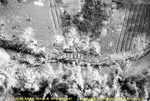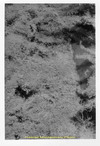I remember the few quiet evenings that we had where my FDC crew and a few others would gather at the picnic table and philosophize about the nature of life, and more important things, like what women really looked like, remembrances of their perfumes, etc. The attack on Burkett that Ralph Porter writes about is fairly well etched in my mind since it was one of the hotter nights we had, but my memories have retreated to the subjective remembrance of events which most personally impressed.
The lingering trace of that period that most strongly survives with me is of an 82 mm mortar round (dud) that stuck its ugly head in the ground about three feet from where my fair head was resting on a cot under a sandbagged culvert. I found the fins growing out of the dirt the next day. Another snippet is of the Arclight strike that went into Cambodia just before the invasion hit. The vision of the veil of smoke rising in the east and continuing to the west as first the vibration, and then the sound traveled the distance from that unfortunate piece of real estate to where we were, is still surreal to me. I don’t know how human beings could have survived within rifle shot of the proceedings. I like to quote Lee, I believe at Fredericksburg, “It is well that war is so terrible, or we would grow to like it too much.” The phenomenon that both horrifies and attracts has to be that utter clarity born of high adrenaline dosage that gets injected automatically when you realize that you have missed death by a matter of inches. This leads me to my story….
Battery “B” of the 6/27th shot an artillery raid, I believe it was early in the spring of 1970, when Col. Leonard Reed was still Battalion Commander. I had been flying with a 23rd Artillery Group Aviation pilot new to me, over the northern edge of the 175 range fan, near the Cambodian border, focusing on the deserted Special Forces base called Bu Gia Map (107o00'73). Like a wayward

But the pits intrigued me, and we began searching the woods surrounding the abandoned base camp. At one point, I remember looking up at the side of a hill as we were flying down a creek basin. We found many signs of activity, including vehicle tracks, small trailside garden plots, some earth covered shelters, and many active trails. All of this activity was just outside the range fan of the guns where they sat at Song Be. Col Reed, taking the cue from my reports, decided that an artillery raid would do the troops good, get the juices flowing, etc, so the thing was planned and came, the tracks moving north by many clicks, until the whole base camp area was under the shadow of 175 rounds with VT fuze. (My own personal favorite fuze, until one went off in a rain squall one day at the same altitude as the Bird Dog I was in, about 1000 feet above ground level. Contemplation thereafter limited my use of VT. But, I digress)
We began by probing some of the areas near the streams where activity was visible with fire. I had spotted bunkers clearly visible under some of the trees, and we had actually gotten some intel on a hospital complex near one stream east of the old base, which

We continued our efforts after his departure, and at one point, we saw some rice mats on the edge of a field, and dove on them. I stuck my M-16 out of the window to poke the rattlesnake, and at the bottom of the dive, was surprised at the break my pilot made when a stream of fire came back to us. We heard rounds hit the aircraft, but could see no visible damage. We adjusted the 175s into the area, and were able to do the war effort some good with two KBA, and continued our efforts with more probing, chewing up another bunker complex, getting some secondary explosions at one point, as I recall.
The real excitement came when we broke to refuel at mid-day. Instead of going back to Quan Loi to save time, we landed on the strip at Song Be, which just happened to be the main street of the province capital, with the seat of government being the end of the runway on the north end. Air Force Bird Dogs and their fuel and revetments were on the east side of the strip, about halfway down. We landed south to north, with the Black Virgin’s sister (Nui Ba Ra) staring at our final approach, and me gazing at the relatively solid building (for that part of Nam) standing at the end of the strip. My worry was that we would land too long, and pay the province chief a surprise visit. This was to be the least of my concerns. My pilot deftly side-slipped, dropped altitude quickly, and greased his final approach very near the foot of the runway. As soon as we touched down, and the wings lost their lift, the nature of the bullet strike became apparent. The aircraft began a sharp uncontrollable veering off of the east side of the runway: what had been hit was our right wheel, which was totally flat, and therefore, an absolute drag on our progress on that side.
We crossed the edge of the runway exactly where the birdmen had sat up their encampment, and I found myself staring ahead, out of the right side window at one of the ingenious rubberized fuel bladders we used over there, with thousands of gallons of high octane aviation gas, peeking over the edge of the earth berm surrounding its bloated shape. My fixation on this bladder grew as I realized we were continuing our right turn progress, in spite of the pilot standing on the left brake to the point where his head seemed to be wedged against the top of the aircraft cabin. As we slowed somewhat, the rate of turn increased, and the aircraft wheeled around to the point where the bladder was dead ahead, the center now invisible to me behind the shoulders of my pilot, but the edges of the bladder were coming up fast. Time seemed to slow to freeze for an instant, and then the aircraft hit a triple band of concertina wire surrounding the berm, and thankfully dipped to a nose-down stop with the top layer of the concertina wrapped around the prop, nose buried in the base of the berm, and me hanging in my straps staring at the hose fixture on top of the bladder through the Plexiglas lites which were cut in the center of the wing over the top of the cockpit.
I can still see that obscure piece of military plumbing, crystal as a day in early spring, no haze in the sky, and colors as fresh and vivid as the first day God made them.
The air crewmen for the gray Bird Dogs came over, grabbed the tail of the aircraft, and pulled us back onto the tail wheel. It took me fifteen seconds to get out of the aircraft, but another five minutes before I could stand still without my knees shaking. The crew chief looked my pilot in the eye and said, “Dang it, we just laid out that concertina last week. Now we have to do it over again.” I think my pilot apologized for the inconvenience. Upon looking at the wheel, a nice neat hole roughly half again the diameter of an AK round went through the bottom inside of the tire, and angled out through the outside face of the aluminum wheel hub. This assumes that that portion of the tire was rotated down when it got hit. Actually, it was probably angled a little fore or aft, or the round would have gone through the fuel tank in the wing as well.
One of the crewmen asked, “What altitude were you flying when you got hit?”
Before my pilot could answer, one of the Air Force Lieutenants said, “Too low, if he got hit at all.” We left it at that.
I think we were probably less than a hundred feet in the bottom of that dive. It was hilly country, and the ground had been coming up to us as we went down to it. It was the only way we could ever see anything, to get right down to the tops of the trees. Whatever later success I had as on observer depended upon how well I could coax my pilots into emulating the actions of this brave man, ignoring the minimum altitude restriction of 1500 feet above ground level, and getting down and dirty.
The only real bravery I will admit to in my entire tour of duty was getting back into that observer’s seat after the wheel had been replaced with one of the Air Force spares, the prop and engine having been given the once over by the Air Force crewmen, and heading back out to the second half of the day’s work. We churned up some more Bu Gia Map real estate, expending a number of rounds satisfactory even to the Battalion XO, and ended the raid without any additional excitement to compare when our gas was again running low. We returned to Quan Loi that time, by mutual agreement between myself and the pilot, after making a low pass over the 175 tracks and giving them an aerial salute, a waggle of the wings.
I only flew this one last mission with that pilot. I never saw him again, and since I had only flown with him a few times before, his name is lost in the fog of time. It is overshadowed by other names whose company I shared many times after, but only one of which, Don, (Bhudda) Sutton, (so named for his resemblance to Hotei, the Happy Bhudda, not for his spiritual prowess,) exhibited quite the same degree of controlled madness that enabled me to get to a place where we could become intimate with nature. I ended up being in the wedding of one of my other pilots, Don York, who was nearly as crazy, and who rented an entire floor of Harrah’s in Lake Tahoe for his marriage in 1976. But that is another story….
Headquarters & Alpha Battery
Sep 1969 to April 1971